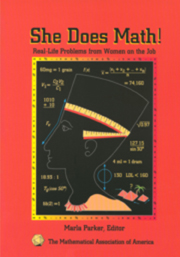Book contents
- Frontmatter
- Preface
- Contents
- Problems by Subject
- Environmental Psychology
- Software Engineering; Computer Science
- Archaeology
- Mathematics and Computer Science
- Civil Engineering
- Mathematics
- Electrical Engineering
- Physics; X-ray Astronomy Research
- Mathematics
- Physics; Astronaut Crew Training Instructor
- Business Data Processing
- Software Engineering; Real Estate Investment
- Quality Engineering
- Health Science
- Nursing Education
- Electrical Engineering; Space Systems
- Oil and Gas Accounting
- Business Administration Higher Education
- Aerospace Engineering
- Structural Engineering
- Computer Science
- Mathematics
- Dietetics—Foodservice Management and Nutrition
- Electrical Engineering
- Chemical Engineering, retired
- Software Engineering
- Immunology and Microbiology
- Mechanical Engineering
- HMO Pharmacy Practice and Management
- Ophthalmology
- Electrical Engineering
- Fish Pathology
- Computer Science and Computer Graphics
- Mathematics and Computing
- Electrical Engineering
- Astronomy
- Author
- Mathematics
- Reflections on WAM
- Solutions
Health Science
- Frontmatter
- Preface
- Contents
- Problems by Subject
- Environmental Psychology
- Software Engineering; Computer Science
- Archaeology
- Mathematics and Computer Science
- Civil Engineering
- Mathematics
- Electrical Engineering
- Physics; X-ray Astronomy Research
- Mathematics
- Physics; Astronaut Crew Training Instructor
- Business Data Processing
- Software Engineering; Real Estate Investment
- Quality Engineering
- Health Science
- Nursing Education
- Electrical Engineering; Space Systems
- Oil and Gas Accounting
- Business Administration Higher Education
- Aerospace Engineering
- Structural Engineering
- Computer Science
- Mathematics
- Dietetics—Foodservice Management and Nutrition
- Electrical Engineering
- Chemical Engineering, retired
- Software Engineering
- Immunology and Microbiology
- Mechanical Engineering
- HMO Pharmacy Practice and Management
- Ophthalmology
- Electrical Engineering
- Fish Pathology
- Computer Science and Computer Graphics
- Mathematics and Computing
- Electrical Engineering
- Astronomy
- Author
- Mathematics
- Reflections on WAM
- Solutions
Summary
At Hunter College High School, I loved math and took almost all the courses that were offered, including trigonometry and solid geometry, but not calculus. I went on to Hunter College where I majored in math with an education minor. I became an assistant in the math department at the University of Wisconsin, where I also earned an MA in math.
Newly married, I next went to the Columbia University School of Pure Science for a PhD. I completed all the courses for the degree, but acquired a family instead—three daughters in four years! While my daughters were young, I worked as an assistant professor of mathematics at Bronx Community College. It was the early 1960's, when a teaching method known as “Programmed Instruction” was very popular, almost a fad. It consisted of a teacher-student dialogue, written in the form of questions and answers.
One day the New York State Department of Education contacted our college, asking for urgent help teaching math to nurses. Although they were otherwise good nurses, many of them had been so badly trained in mathematics, or had so little faith in their ability to do math, that they were actually causing health problems. Poor math skills were causing them to make errors in documentation and dosage calculations.
Using Programmed Instruction to teach math to nurses seemed like an interesting doctoral project, so I returned to Columbia's Teachers College and completed an EdD. This resulted in the publication (by Wiley) of Mathematics for Nursing Science in 1965, with a second edition in 1977.
- Type
- Chapter
- Information
- She Does Math!Real-Life Problems from Women on the Job, pp. 56 - 57Publisher: Mathematical Association of AmericaPrint publication year: 1995

